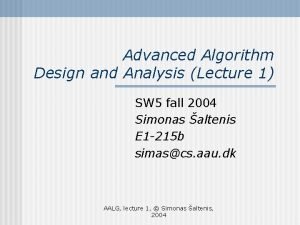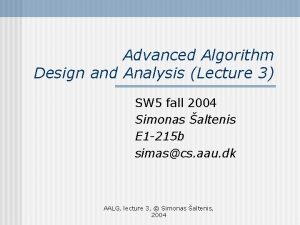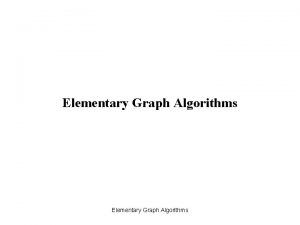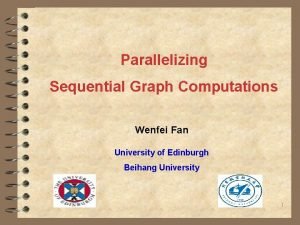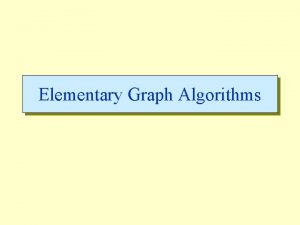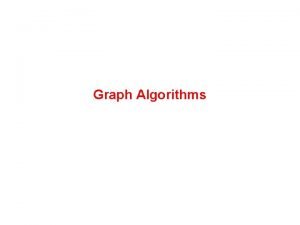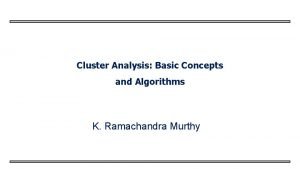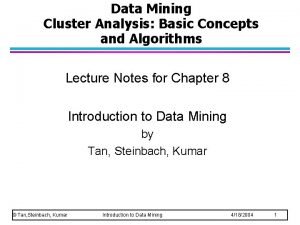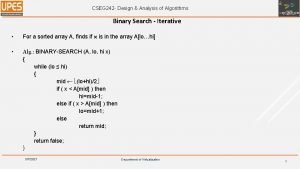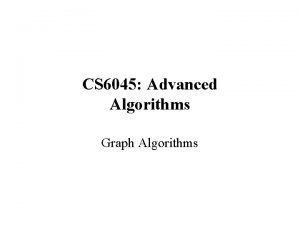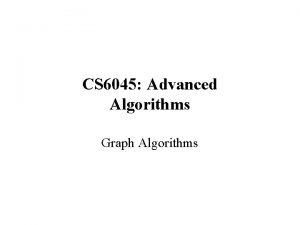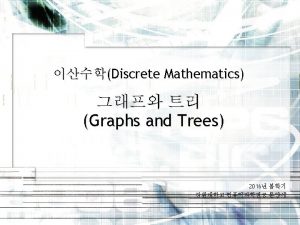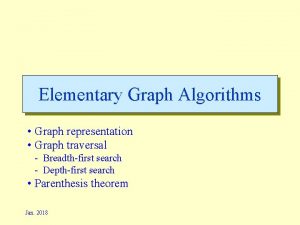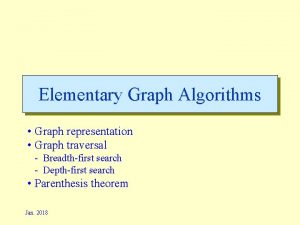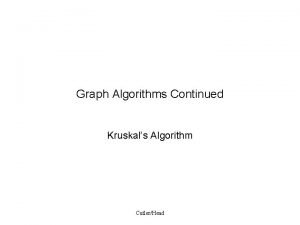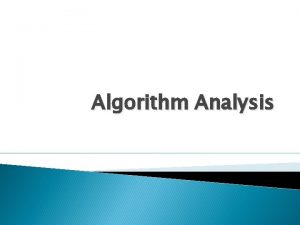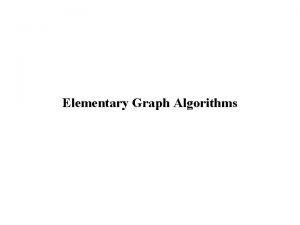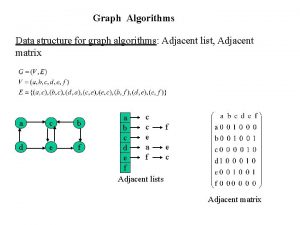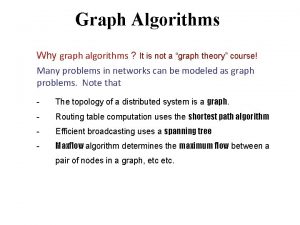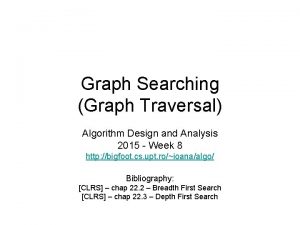Advanced Algorithm Analysis Graphs and Graph Algorithms Graphs




















- Slides: 20

Advanced Algorithm Analysis Graphs and Graph Algorithms

Graphs A (simple) graph G = (V, E) consists of • V, a nonempty set of vertices • E, a set of unordered pairs of distinct vertices called edges. Examples:

Directed Graphs A directed graph (or digraph) G = (V, E) consists of • V, a nonempty set of vertices • E, a set of ordered pairs of distinct vertices called edges. Examples:

Weighted Graph A weighted graph is a triple G = (V, E, W) • where (V, E) is a graph (or a digraph) and • W is a function from E into R, the reals (integer or rationals). • For an edge e, W(e) is called the weight of e. A weighted digraph is often called a network. Examples

Graph Terminology Let u and v be vertices, and let e = (u, v) be an edge in an undirected graph G. • The vertices u and v are adjacent. • The edge e is incident with both vertices u and v. • The edge e connects u and v. • The vertices u and v are the endpoints of edge e. • The degree of a vertex, denoted deg(v), in an undirected graph is the number of edges incident with it (where self-loops are counted twice).

Vertex Degree Examples

More Graph Terminology A subgraph of a graph G = (V, E) is a graph G = (V , E ) such that V V and E E. A path is a sequence of vertices v 1, v 2, v 3, …, vk such that consecutive vertices vi and vi+1 are adjacent.

Graph Representations using Data Structures Adjacency Matrix Representation • Let G = (V, E), n = |V|, m = |E|, V = {v 1, v 2, …, vn) • G can be represented by an n n matrix Design and Analysis of Algorithms - Chapter 5 19

Adjacency Matrix for weight digraph

Adjacency List Representation Design and Analysis of Algorithms - Chapter 5 21

Weighted Digraph Adjacency List Representation Design and Analysis of Algorithms - Chapter 5 22 from -> to, weight

More Definitions Subgraph Symmetric digraph Complete graph Adjacency relation Path, simple path, reachable Connected, Strongly Connected Cycle, simple cycle Acyclic Andirected forest Free tree, undirected tree Rooted tree Connected component

Traversing Graphs Algorithms Most algorithms for solving problems on a graph examine or process each vertex and each edge. Depth-First Search (DFS) and Breadth-First Search (BFS) • Two elementary traversal strategies that provide an efficient way to “visit” each vertex and edge exactly once. • Both work on directed or undirected graphs. • Many advanced graph algorithms are based on the concepts of DFS or BFS. • The difference between the two algorithms is in the order in which each “visits” vertices.

Depth-first search Explore graph always moving away from last visited vertex Similar to preorder tree traversals Pseudocode for Depth-first-search of graph G=(V, E) DFS(G) count : =0 mark each vertex with 0 (unvisited) for each vertex v V do if v is marked with 0 dfs(v) count : = count + 1 mark v with count for each vertex w adjacent to v do if w is marked with 0 dfs(w)

Example – undirected graph a b c d e f g h Depth-first traversal:

Types of edges Tree edges: edges comprising forest Back edges: edges to ancestor nodes Example – directed graph Forward edges: edges to descendants (digraphs only) DFS can be implemented with graphs represented as: • Adjacency matrices: Θ(V 2) • Adjacency linked lists: Θ(V+E) b c d e f g h Depth-first traversal: Cross edges: none of the above Depth-first search: Notes a Yields two distinct ordering of vertices: • preorder: as vertices are first encountered (pushed onto stack) • postorder: as vertices become dead-ends (popped off stack) Applications: • checking connectivity, finding connected components • checking acyclicity • searching state-space of problems for solution (AI) Breadth-first search Explore graph moving across to all the neighbors of lastvisited vertex Similar to level-by-level tree traversals Instead of a stack, breadth-first uses queue Applications: same as DFS, but can also find paths from a vertex to all other vertices with the smallest number of edges

Breadth-first search algorithm BFS(G) count : =0 mark each vertex with 0 for each vertex v V do bfs(v) count : = count + 1 mark v with count initialize queue with v while queue is not empty do a : = front of queue for each vertex w adjacent to a do if w is marked with 0 count : = count + 1 mark w with count add w to the end of the queue remove a from the front of the queue Example – undirected graph a b c d e f g h Breadth-first traversal:

Example – directed graph a b c d e f g h Breadth-first traversal:

Breadth-first search: Notes BFS has same efficiency as DFS and can be implemented with graphs represented as: • Adjacency matrices: Θ(V 2) • Adjacency linked lists: Θ(V+E) Yields single ordering of vertices (order added/deleted from queue is the same)

Directed acyclic graph (dag) A directed graph with no cycles Arise in modeling many problems, eg: • prerequisite structure • food chains Imply partial ordering on the domain
 Interpolation search formula
Interpolation search formula Advanced algorithm analysis
Advanced algorithm analysis Advanced algorithm analysis
Advanced algorithm analysis Elementary graph algorithms
Elementary graph algorithms Incrementalizing graph algorithms
Incrementalizing graph algorithms Elementary graph algorithms
Elementary graph algorithms Undirected graph algorithms
Undirected graph algorithms Networks and graphs circuits paths and graph structures
Networks and graphs circuits paths and graph structures Good state graphs and bad state graphs in software testing
Good state graphs and bad state graphs in software testing Graphs that enlighten and graphs that deceive
Graphs that enlighten and graphs that deceive 1001 design
1001 design Association analysis: basic concepts and algorithms
Association analysis: basic concepts and algorithms Cluster analysis basic concepts and algorithms
Cluster analysis basic concepts and algorithms Randomized algorithms and probabilistic analysis
Randomized algorithms and probabilistic analysis Design and analysis of algorithms introduction
Design and analysis of algorithms introduction Cluster analysis basic concepts and algorithms
Cluster analysis basic concepts and algorithms Cjih
Cjih Exercise 24
Exercise 24 Binary search in design and analysis of algorithms
Binary search in design and analysis of algorithms Introduction to the design and analysis of algorithms
Introduction to the design and analysis of algorithms Design and analysis of algorithms
Design and analysis of algorithms

